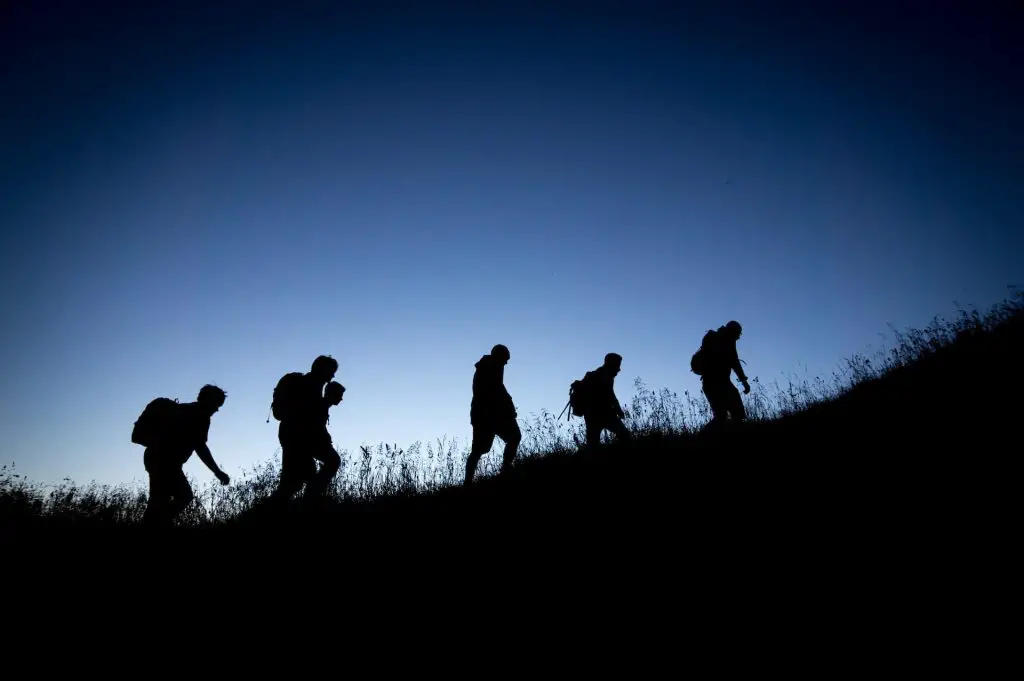Hiking at night adds to the ambiance of a good hike, but the lack of sun can lead to a very cold hike. Not only do you have to focus on each step, but also how to stay warm on your upcoming night hike. What can you do to stay warm on a night hike?
The best way to stay warm on a night hike is to use a layering system with a good base layer, insulation layer down jacket, and having a rain jacket as an outer shell. You can also wear things like a beanie or balaclava to keep your head warm, wool socks to keep your feet warm, and gloves combined with hand warmers to keep your fingers comfortable.
Staying warm on a night hike can be a challenge, but if you follow the tips below and the considerations for each piece of gear then you will be able to be warm on your next night hike. I have been on many night hikes over the years and this strategy has kept me warm time and time again. Being warm on your hike will allow you to enjoy the sights and sounds of your next night hike.
Layering System to Stay Warm

Base Layer
The first layer of the system is the base layer. This is the piece of clothing that sits directly on your skin. For a base layer you should get a moisture-wicking long sleeve polyester or wool shirt. The moisture-wicking will help keep sweat away from your body so that if there is any wind you won’t get the chills. The wool and polyester will dry quickly and keep your body warm. Having the base layer is just the start, but heat will escape quickly from your body if this is your only piece of clothing.
Insulation Layer
The next layer of the system is a good insulation layer. This can either be a down jacket or a fleece jacket. The jacket helps keep your body heat trapped and helps keep you warmer. For a down jacket you can get either synthetic down or real down, it just depends on how hot you run and how cold you expect the weather to be. This layer is the one that will make you feel the warmest. The dense fleece or the down feathers will help trap heat and keep you warm. I always enjoy putting on my down jacket as I feel warm and cozy on my hikes.
Outer Layer
The final layer of the system is an outer layer or outer shell. This layer will help block you from the elements. This outer layer should be rated to block wind and be water proof. While the insulation layer traps heat, the outer layer helps block wind so that your heat does not get dispersed. If there are heavy winds then it can feel much colder as there is the base temperature and the temperature with wind chill. For my outer layer I like to get jackets with zippers under the armpits to help air it out to prevent too much moisture build up. It is a balancing act of staying warm enough but not get too warm where you are sweating too much.
Accessories to Help You Stay Warm On Night Hikes

Beanies
With the layering system you have your upper body covered, but your head is still exposed. One thing I always bring is a beanie to help keep my head warm. For beanies you should try to get moisture-wicking wool. You should avoid cotton beanies as they will soak in your sweat and stay wet during the night. Any wind you may encounter may make your head even colder.
Our Favorite Smartwool Beanie on Amazon
Balaclavas
An alternative to wearing beanies is to use a balaclava. Balaclavas keep your head warm cause they wrap around the top of your head, ears, and mouth. This helps trap any heat from your head. I usually bring a balaclava when I know the temperature is really low and I want to keep my entire face warm. If you’re hiking in the winter, here are other ways you can keep your face warm.
Our Favorite Balaclava from Under Armour on Amazon
Pants
You got your entire upper body covered, but what about your legs? Some hiking pants can be very thin and your legs will feel very cold. What you can do is wear a base layer on your legs that go underneath your pants. You would of course need baggier hiking pants in order for the base layer to comfortably fit. Find a good pair of moisture-wicking pant base layers that are made of either wool or polyester. I typically wear a pants base layer in the snow or when its below 40 degrees.
Our Favorite Men’s Hiking Pants from prAna on Amazon
Our Favorite Women’s Hiking Pants from prAna on Amazon
Wool Socks
Moving down to the very bottom of your body, your feet. To protect your feet and keep them warm you should get some nice wool socks. Wool socks are great cause they are breathable and help trap the heat from your feet. You can choose from a range of thickness depending on how cold it will be.
Our Favorite Wool Hiking Socks from Darn Tough on Amazon
Gloves
The last thing most people think about is their hands and fingers. You can wear some thin gloves to block from the wind to prevent your hands from freezing. Usually my hands get so cold I stop thinking about them but its really nice to have gloves.
Hand Warmers
The next item to help keep you warm is to bring some disposable hand warmers. These hand warmers generate heat after being opened and really do help out a lot. You can place them inside your jacket to keep your body warm. You can also place them inside your gloves to help warm your hands. You can also place them in your pockets to warm your thighs. These are especially helpful on incredibly cold hikes.
Our Favorite Hand Warmers on Amazon
Final Thoughts
Heading out on a night hike is a very fun adventure. Keeping yourself warm with a layering system and all of the additional accessories will allow you to stay cozy and enjoy the hike. If you’re going camping and feel cold, here’s how you can add warmth to your sleeping bag. After years of hiking and figuring out a good system, I have been able to enjoy many amazing night hikes. Have a fun and safe trip on your next night hike!
